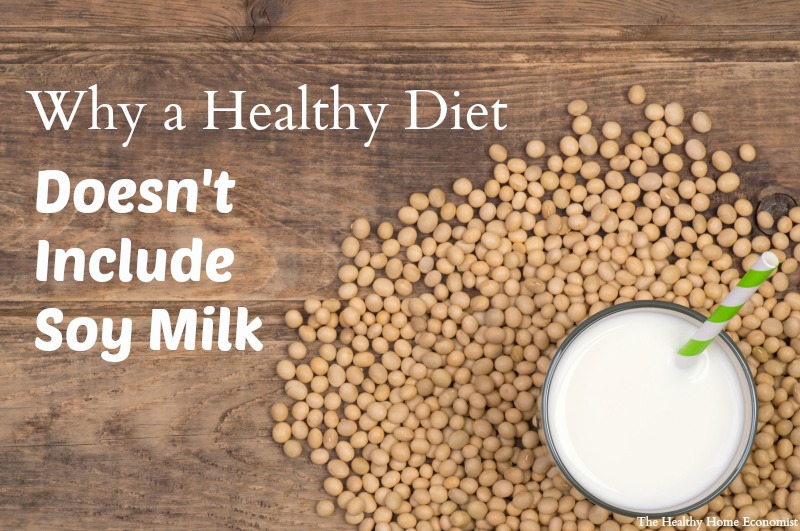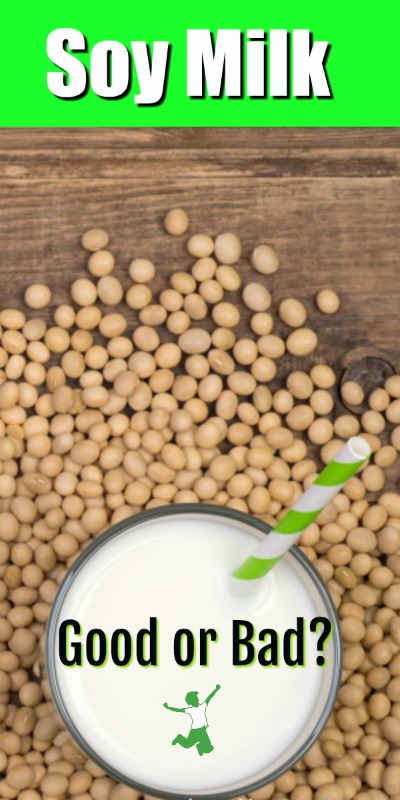Table of Contents[Hide][Show]
Soy milk is widely perceived as a healthy alternative to dairy milk, but an examination of the history and processing of this modern beverage reveals otherwise.
Like many people, I got suckered on to the “soy is good for you” train back in the 1990s. I drank soy milk nearly every day for several years thinking it was a healthy and nutritious alternative to processed dairy.
This favorable opinion of soy milk abruptly changed when I became pregnant with my first child in 1998. Suddenly, I didn’t want my daily glass or two of organic vanilla soy milk anymore. The thought of taking a sip made me nauseous even though my morning sickness was minimal. Worse, the smell of the stuff made me gag. Figuring my body was instinctively trying to communicate something my intellect didn’t quite yet understand, I threw out my carton of soy milk and never bought it again.
Isn’t Soy Milk Better than Commercial Dairy?
A couple of years later, I revisited the issue of soy milk when my first baby was ready to be weaned. I didn’t want him drinking pasteurized supermarket milk loaded with steroids and hormones. I also knew that organic milk wasn’t much better due to the high amount of processing which denatures the milk proteins.
Research reveals a dirty little secret about UHT organic milk. It is packaged in plastic-lined aseptic cartons with the boiling hot milk poured in before sealing. This effectively sterilizes the container allowing the milk to be shelf-stable for months. But, leaching of chemicals from the plastic into the organic milk no doubt occurs.
As a confused Mom, I asked my practitioner at the time about whether soy milk or a soy milk/rice milk blend would be a good choice for my toddler. Thank goodness for his emphatic “no” answer. His candor likely saved my son and future children from health issues down the road.
What’s Wrong with One Glass of Soy Milk Per Day?
For those examining the issue of whether or not to drink soy milk, the overly sweetened, synthetically fortified soy milk brands from the store stand out as unhealthy. But what about the organic unsweetened ones? Can these be considered a healthy type of soy milk?
Dr. Kaayla Daniel PhD, author of The Whole Soy Story says that even organic, unsweetened soya milk with no additives is a risky choice.
The high level of anti-nutrients in the form of phytates and protease inhibitors combined with hormone-disrupting isoflavones (phytoestrogens) in a single glass is such that consuming even that small amount every day could lead to thyroid damage within just a few months (1).
I have always counted myself extremely fortunate that I didn’t blow out my thyroid during those years of soy milk drinking before I had children. Many others are not so lucky. The hypothyroid epidemic is especially prevalent among women with hot flashes sold the bill of goods that soy can help alleviate menopause symptoms.
Soya Milk and SODD
It’s not just the delicate thyroid gland that is at risk either. Regular consumption of soy milk, or soya milk as it is called in other countries, exposes a person to what’s known as Soy Originated Disease and Disorders or SODD.
The list of conditions that fall under SODD includes the following:
- thyroid damage
- soy allergies
- immune system breakdown
- reproductive disorders (including infertility)
- ADD/ADHD and other behavioral and learning disabilities
- depression
- violent tendencies
- anxiety
- other mental health issues
Soy Milk for Children
Unfortunately, babies whose parents unwittingly put them on soy formula, “soy milk for babies”, at the recommendation of a well-meaning, but poorly researched practitioner are most at risk for these long term problems.
Children fed soy infant formula during the first six months of life are at risk for excessive levels of manganese. Manganese found in soy formula are 50-80 times the amount found in breastmilk, commercial or homemade dairy formula (2).
The potential effect of high manganese in a developing child with an immature liver is ADD/ADHD and other behavioral disorders and learning disabilities. Violent tendencies are also a scary possibility.
Another problem is that soy formula floods an infant’s system with plant hormones. These phytoestrogens consumed day after day can disrupt proper hormonal development years later at puberty. The risk is for both boys and girls.
The most significant dietary association with premature sexual development in children is soy infant formula. The second most powerful association is frequent consumption of chicken raised on soy-based feed (3).
Zinc Deficiency
Babies on soy formula and children weaned onto soy milk are at great risk for zinc deficiency. The potent phytates in soy block zinc absorption by the body. Zinc is called “the intelligence mineral”. It is also important to memory and learning.
The potential for zinc deficiency in edamame munching, soy milk drinking children puts long term IQ and even success at school at risk.
Heavy Metals
Soy consumption, in general, carries the risk of heavy metal toxicity. This can happen for a couple of reasons according to Dr. Daniel:
First, soy milk and other soya products are commonly processed with aluminum. This combined with the use of fluoridated water during processing increases the risk of aluminum contamination.
Secondly, soy consumption at the expense of meat and other complete protein foods can contribute to low levels of the semi-essential amino acid cysteine, the mineral zinc, and Vitamin B5 – pantothenic acid. These nutrients are all necessary for proper detoxification. When detox pathways are impaired, a buildup of mercury, cadmium, arsenic, aluminum and other heavy metals can occur from the many routes of exposure in our toxic world today.
Hair Analysis Can Reveal Hidden Toxins
The body uses hair to eliminate metals, so a simple hair analysis can reveal if this is a problem for you. However, if adrenal exhaustion is present, a hair test may only reveal aluminum at first. A practitioner well versed in SODD will know how to analyze the results to see if hidden metals are likely and whether follow-up hair tests are necessary after soy recovery protocols are initiated.
Note that soya lecithin does not present the same dangers as soy foods. It is typically used by food manufacturers in very small amounts added as an emulsifier. It is still best to ensure that the soy is organic or certified nonGMO, however.
Asians Drink Lots of Soy Milk?
Many proponents of soy milk counter the above arguments by pointing out that Asians drink soy milk and have been eating soy for thousands of years.
It is true that Asians have consumed soy for thousands of years. Soy appeared in the Asian diet in the late Chou dynasty, 1134-246 BC. However, the ancient soy consumed was not the nonfermented, high phytate kind found in soy milk and other modern soy foods.
Ancestral Asian cultures primarily consumed soy only after it had been carefully fermented for long periods of time. This traditional preparation eliminated most of the anti-nutrients (phytates). These ancestral, fermented soy foods include tempeh, miso, natto, and traditionally brewed soy sauce.
The term soy milk was ancestrally used to reference the making of tofu, not a commonly consumed beverage. The appearance of commercial soy milk in Asian stores only occurred in recent decades (4). It is a quintessential modern food!
It is a myth that Asians consume soy foods in large quantities even when fermented. According to the Weston A. Price Foundation, the average consumption of soy foods in Japan and China is about 2 teaspoons per day. This small amount of soy is served as a condiment and not as a replacement for meat or dairy.
Homemade Soy Milk
What about homemade soy milk made with the popular stainless steel, automatic soymilk makers? Surely this would be a healthy option to soy milk in cartons from the store, right?
Making soy milk at home with organic soybeans ensures a fresh and clean product compared with commercial versions. Before you run out and buy one of these gadgets, note what Dr. Daniel has to say:
… it’s “buyer beware” when it comes to some of the speedy new machines on the market. Robert Cohen — the “Not Milk Man” who has assertively publicized the health dangers of commercial dairy products — is the man who came up with the soy milk machine known as the SoyToy. Ignoring centuries of accrued wisdom, Cohen boasts that his machine makes soy milk in only 25 minutes and does not require presoaked beans. Soy milk that has not been properly soaked, skimmed and cooked at length is “all natural” all right and guaranteed to deliver a full load of the soybean’s antinutrients (5).
While commercial versions of soy milk present heavy metal toxicity risk due to processing, this processing does reduce some of the potent anti-nutrients in the soybean at least. Quick-made soymilk from home appliances is going to be loaded with these anti-nutrients to a much higher degree though the risk of metals may be lower.
Pick your poison.
Sprouted Soy Milk
When legumes germinate, the natural chemical process significantly reduces mineral blocking, digestive distress inducing phytates and other anti-nutrients. Since the soybean is a legume, would sprouted soybean milk be an option? There are recipes out there on how to make this yourself at home, which has caught on in some vegetarian circles.
Unfortunately, sprouted soybeans are quite unlike other legumes like peas, lentils, chickpeas, and beans. The phytates in soy actually become more concentrated when sprouted. In addition, sprouting does nothing to reduce the phytoestrogen content of the soybean nor does it mitigate the powerful goitrogenic effect on the thyroid gland.
Steer clear!

Is Soy Milk Ever a Good Idea?
It seems best to skip the soy milk altogether in the final analysis. Soy milk has no benefits in the diet whatsoever. Neither commercial soy milk nor homemade soy milk presents a viable dairy-free beverage alternative for long term health. If you don’t have a dairy allergy, grass-fed raw milk is the best choice all around.
If dairy allergies are present, coconut milk, wild rice milk, or almond milk are better alternatives. Be aware that commercial preparations of these beverages carry risks in the form of additives, synthetic vitamins, and GMOs. In addition, toxic packaging is a risk from plastic-lined cartons or BPA lined cans. As a result, it is best to prepare them yourself if at all possible. This article contains some easy recipes for milk substitutes to consider.
It seems the FDA is finally realizing that soy milk is fooling a lot of people and potentially harming their health in the process. As of July 2018, reports are that the FDA will crack down on soy manufacturers, no longer allowing them to call a soya-based beverage “soy milk”. (6)
Soy Milk Exposed VIDEO
The video below summarizes the health issues and overall dangers of consuming soy milk, especially for children. Please share with your soymilk drinking friends before their soya habit triggers a hormonal nightmare!








Leave a Reply